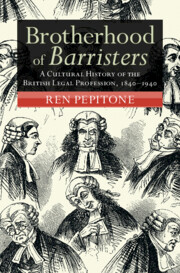245 results
Chapter 5 - Roman Topography, Politics and Gender
-
-
- Book:
- The Augustan Space
- Print publication:
- 27 June 2024, pp 85-97
-
- Chapter
- Export citation
3 - Son of a Bitch
-
- Book:
- Bitch
- Print publication:
- 27 June 2024, pp 69-97
-
- Chapter
- Export citation
Chapter 4 - Patterns of Industry
-
-
- Book:
- Nineteenth-Century Literature in Transition: The 1830s
- Published online:
- 30 May 2024
- Print publication:
- 06 June 2024, pp 84-104
-
- Chapter
- Export citation
24 - Sex in Shanghai in the Twentieth Century: Intimate Negotiations
-
-
- Book:
- The Cambridge World History of Sexualities
- Published online:
- 26 April 2024
- Print publication:
- 16 May 2024, pp 508-531
-
- Chapter
- Export citation
2 - Sex in Rome in the First Century bce and the First Century ce
-
-
- Book:
- The Cambridge World History of Sexualities
- Published online:
- 26 April 2024
- Print publication:
- 16 May 2024, pp 27-46
-
- Chapter
- Export citation
1 - Introduction
-
- Book:
- Brotherhood of Barristers
- Published online:
- 11 April 2024
- Print publication:
- 18 April 2024, pp 1-18
-
- Chapter
- Export citation
5 - Overseas Students
-
- Book:
- Brotherhood of Barristers
- Published online:
- 11 April 2024
- Print publication:
- 18 April 2024, pp 121-156
-
- Chapter
- Export citation
3 - The Culture of the Bar
-
- Book:
- Brotherhood of Barristers
- Published online:
- 11 April 2024
- Print publication:
- 18 April 2024, pp 52-89
-
- Chapter
- Export citation

Brotherhood of Barristers
- A Cultural History of the British Legal Profession, 1840–1940
-
- Published online:
- 11 April 2024
- Print publication:
- 18 April 2024
Introduction
-
- Journal:
- International Labor and Working-Class History / Volume 105 / April 2024
- Published online by Cambridge University Press:
- 05 April 2024, pp. 1-8
-
- Article
-
- You have access
- Open access
- HTML
- Export citation
Beyond the masculinity of kingship: The making of a modern queen in early second millennium Sri Lanka
-
- Journal:
- Modern Asian Studies , First View
- Published online by Cambridge University Press:
- 01 April 2024, pp. 1-27
-
- Article
-
- You have access
- Open access
- HTML
- Export citation
10 - Social Justice or Sexual Justice?
-
-
- Book:
- Social Justice in Twentieth-Century Europe
- Published online:
- 29 February 2024
- Print publication:
- 07 March 2024, pp 205-223
-
- Chapter
- Export citation
Racial Colonists in the Nazi East: Disabled Veterans and the Malleable Boundaries of Race, Masculinity, and Disability
-
- Journal:
- Central European History / Volume 57 / Issue 1 / March 2024
- Published online by Cambridge University Press:
- 25 January 2024, pp. 59-77
- Print publication:
- March 2024
-
- Article
-
- You have access
- Open access
- HTML
- Export citation
An Awkward Predicament: “The German Man” and Feminized Modernity in the 1840s
-
- Journal:
- Central European History / Volume 57 / Issue 1 / March 2024
- Published online by Cambridge University Press:
- 12 January 2024, pp. 1-24
- Print publication:
- March 2024
-
- Article
-
- You have access
- Open access
- HTML
- Export citation
Chapter 6 - The ‘Trojan’ Boar (Aper troianus ostentator)
-
- Book:
- The Trojan Horse and Other Stories
- Published online:
- 09 November 2023
- Print publication:
- 11 January 2024, pp 135-162
-
- Chapter
- Export citation
4 - “Don’t kill such an old creature as I”
- from Part I - The Enslaved
-
- Book:
- Old Age and American Slavery
- Published online:
- 27 October 2023
- Print publication:
- 16 November 2023, pp 136-163
-
- Chapter
- Export citation
When he smiles: Attractiveness preferences for male faces expressing emotions
-
- Journal:
- Evolutionary Human Sciences / Volume 5 / 2023
- Published online by Cambridge University Press:
- 14 November 2023, e31
-
- Article
-
- You have access
- Open access
- HTML
- Export citation
31 - Gendered Nations and Institutions
- from Part III - Intersections: National(ist) Synergies and Tensions with Other Social, Economic, Political, and Cultural Categories, Identities, and Practices
-
-
- Book:
- The Cambridge History of Nationhood and Nationalism
- Published online:
- 08 November 2023
- Print publication:
- 09 November 2023, pp 661-681
-
- Chapter
- Export citation
8 - Success Is the Only Virtue
- from Part III - The New Class Conflict, c.1975–2008
-
- Book:
- Virtue Capitalists
- Published online:
- 07 September 2023
- Print publication:
- 21 September 2023, pp 232-253
-
- Chapter
- Export citation
5 - Female Entrepreneurs
-
- Book:
- Entrepreneurs in Contemporary China
- Published online:
- 24 August 2023
- Print publication:
- 07 September 2023, pp 98-118
-
- Chapter
- Export citation



